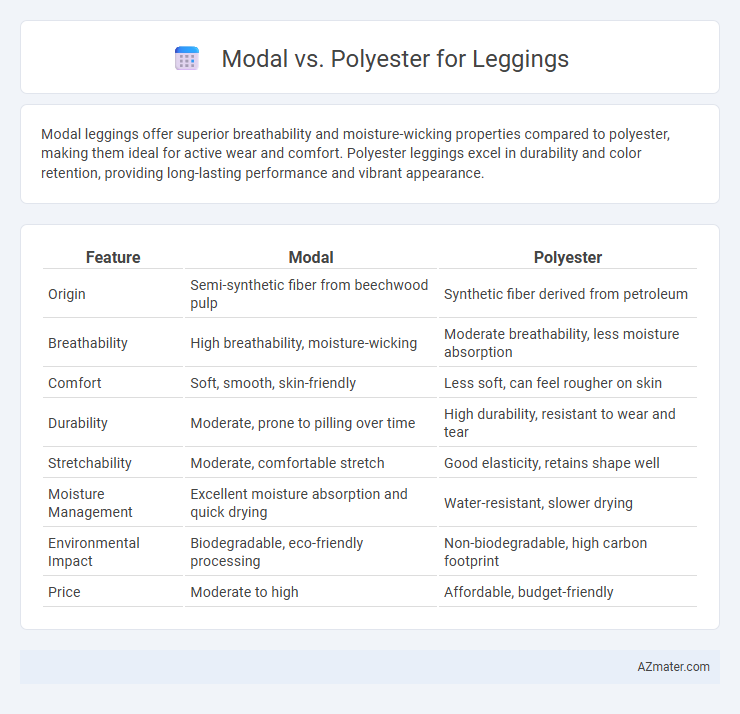Modal leggings offer superior breathability and moisture-wicking properties compared to polyester, making them ideal for active wear and comfort. Polyester leggings excel in durability and color retention, providing long-lasting performance and vibrant appearance.
Table of Comparison
| Feature | Modal | Polyester |
|---|---|---|
| Origin | Semi-synthetic fiber from beechwood pulp | Synthetic fiber derived from petroleum |
| Breathability | High breathability, moisture-wicking | Moderate breathability, less moisture absorption |
| Comfort | Soft, smooth, skin-friendly | Less soft, can feel rougher on skin |
| Durability | Moderate, prone to pilling over time | High durability, resistant to wear and tear |
| Stretchability | Moderate, comfortable stretch | Good elasticity, retains shape well |
| Moisture Management | Excellent moisture absorption and quick drying | Water-resistant, slower drying |
| Environmental Impact | Biodegradable, eco-friendly processing | Non-biodegradable, high carbon footprint |
| Price | Moderate to high | Affordable, budget-friendly |
Introduction to Modal and Polyester Leggings
Modal leggings are crafted from a semi-synthetic fabric derived from beech tree pulp, renowned for its softness, breathability, and moisture-wicking properties, making them ideal for comfort and activewear. Polyester leggings, made from synthetic polymer fibers, offer superior durability, shape retention, and resistance to wrinkles and shrinking, which makes them a popular choice for intense workouts and everyday wear. Both fabrics provide distinct benefits, with modal leggings emphasizing comfort and natural feel, while polyester prioritizes performance and longevity.
What is Modal Fabric?
Modal fabric is a type of semi-synthetic cellulose fiber derived from beech tree pulp, known for its exceptional softness and breathability, making it ideal for leggings. It offers high moisture absorbency, ensuring comfortable wear during physical activities, while maintaining durability and resistance to shrinkage and pilling. Compared to polyester, modal leggings provide a more natural feel with superior moisture-wicking properties and enhanced stretch recovery.
What is Polyester Fabric?
Polyester fabric is a synthetic material made from petroleum-based fibers, known for its durability, wrinkle resistance, and moisture-wicking properties, making it a popular choice for activewear such as leggings. Unlike modal, which is derived from natural cellulose fibers and offers a softer, more breathable feel, polyester provides greater elasticity and shape retention, ideal for high-performance activities. Its quick-drying nature and resistance to shrinking or stretching ensure leggings maintain their fit and appearance over time.
Comfort: Modal vs Polyester
Modal leggings offer superior comfort due to their softness, breathability, and moisture-wicking properties, making them ideal for all-day wear and sensitive skin. Polyester leggings provide durability and stretch but may trap heat and moisture, leading to less comfort during extended use. Choosing modal ensures a lightweight, smooth feel, while polyester prioritizes resilience and shape retention.
Moisture-Wicking and Breathability
Modal fabric offers superior moisture-wicking properties compared to polyester, making it ideal for leggings designed to keep skin dry during intense workouts. Polyester, while durable and moisture-resistant, often traps heat and lacks the breathability that modal provides, leading to less comfort in hot or humid conditions. For leggings prioritizing breathability and quick-drying performance, modal blends are generally more effective than pure polyester options.
Durability and Longevity
Modal leggings offer superior softness but tend to have lower durability compared to polyester, which is known for its strength and resistance to wear and tear. Polyester leggings maintain shape and color over time, making them ideal for frequent use and intense workouts. When prioritizing longevity, polyester provides a more durable option, while modal emphasizes comfort and breathability.
Environmental Impact: Modal vs Polyester
Modal leggings are more environmentally friendly than polyester, as modal is made from sustainably sourced beechwood trees through an eco-conscious production process that uses less water and energy. Polyester, a synthetic fabric derived from petroleum, has a significant environmental impact due to its reliance on fossil fuels and the release of microplastics during washing. Modal fibers are biodegradable, reducing long-term pollution, whereas polyester can persist in ecosystems for hundreds of years.
Care and Maintenance Tips
Modal leggings require gentle washing with cold water and mild detergent to maintain softness and prevent shrinkage, while avoiding bleach and fabric softeners preserves fabric integrity. Polyester leggings benefit from machine washing in warm water and tumble drying on low heat, as the synthetic fibers resist wrinkles and retain shape. Both fabrics should be turned inside out during washing to prolong color vibrancy and prevent pilling for long-lasting wear.
Cost Comparison
Modal leggings typically cost more than polyester leggings due to the higher price of modal fabric, which is derived from beech tree pulp and offers superior softness and breathability. Polyester leggings are generally more affordable, benefiting from large-scale mass production and synthetic fiber costs. Choosing between modal and polyester leggings often depends on budget considerations alongside desired comfort and durability.
Which Legging Fabric is Best for You?
Modal leggings offer superior softness, breathability, and moisture-wicking properties, making them ideal for sensitive skin and active wear. Polyester leggings provide excellent durability, stretch retention, and quick-drying capabilities, suited for high-impact workouts and extended use. Choosing the best fabric depends on whether comfort and breathability or long-lasting performance and stretch are your primary priorities.

Infographic: Modal vs Polyester for Legging
 azmater.com
azmater.com